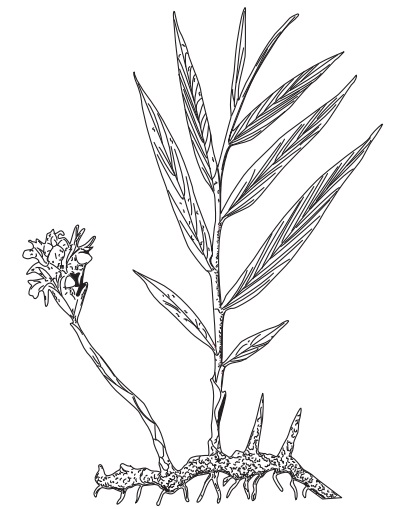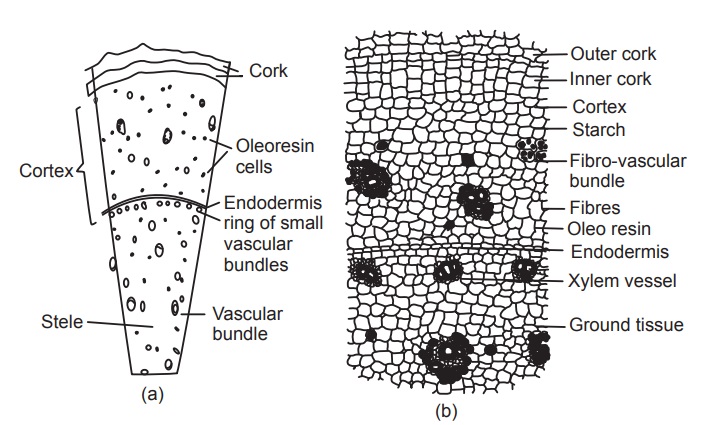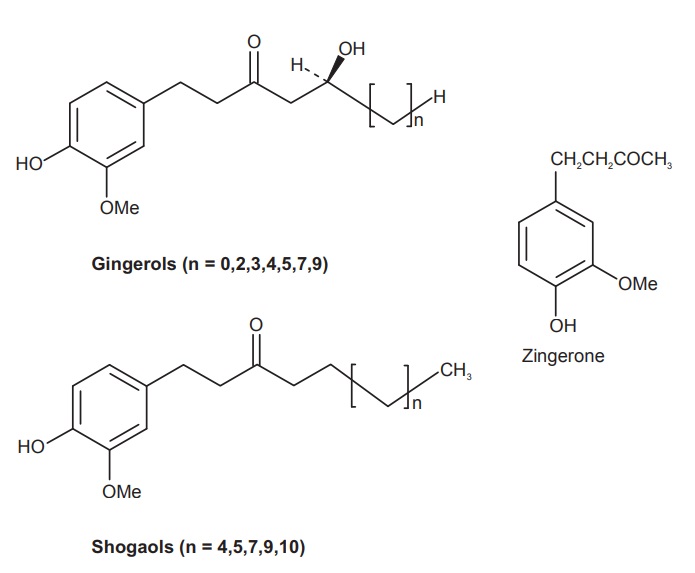Ginger
| Home | | Pharmacognosy |Chapter: Pharmacognosy and Phytochemistry : Drugs Containing Resins
Ginger consists of the dried rhizomes of the Zingiber officinale Roscoe, belonging to family Zingiberaceae.
GINGER
Synonyms
Rhizoma zingiberis, Zingibere.
Biological Source
Ginger consists of the dried rhizomes of the Zingiber officinale Roscoe, belonging to
family Zingiberaceae.
Geographical Source
It is mainly cultivated in West Indies, Nigeria, Jamaica,
India, Japan, and Africa.
Cultivation
Ginger plant is a perennial herb that grows to 1 m. It is
cultivated at an altitude of 600 to 1,500 m above sea level. The herb grows
well in well-drained rich, loamy soil, and in abundant rain fall. The rhizome
is cut into pieces called fingers, and each finger consisting of a bud is placed
in a hole filled with rotten manure in March or April. The rhizomes get matured
in December or January. By January the plants wither after flowering and then
the flowers are forked up, buds and the roots removed and washed to remove the
mould and clay or dirt attached to them. The rhizomes are socked in water overnight
and the next morning they are scraped with a knife to remove the outer cork and
little of parenchyma. They are washed again and then dried under sun for a
week. The rhizomes are turned by the sides at regular intervals to facilitate
proper drying. This is the ‘unbleached Jamaica’ or the uncoated ginger. The
coated or the unpeeled variety is prepared by dropping the rhizome for few
minutes in boiling water, and then skin is removed such that the layer on the
flat surface is removed but not in the grooves between the branches. The
‘bleached’ or ‘limed’ is prepared by treating it with sulphuric acid or
chlorine or dusting it with calcium sulphate or calcium carbonate.
Characteristics
The rhizomes are 5 to 15 cm long, 3 to 6 cm wide, and about
1.5 cm thick. The Jamaica ginger occurs as branches. It has a sympodial
branching and the outer surface has buff yellow colour with longitudinally
striated fibres. Small circular depressions at the portion of the buds are seen
and fractured surface shows narrow bark, a well-developed endodermis, and a
wide stele, with scattered small yellowish points of secretion cells and
grayish points of fibrovascular bundles. The ginger has agreeable and aromatic
odour and pungent and agreeable taste.

Microscopy
The cork is the outermost layer with irregular
parenchymatous cells and dark brown colour. The inner cork is few layered,
colourless parenchymatous cells arranged in radial rows. Cork is absent in
Jamaica ginger. Phellogen is indistinct and the cortex consists of thin-walled
rounded parenchyma with intercellular spaces consisting of abundant starch
grains. The starch grains are simple, ovate, or sac shaped. Numerous yellowish
brown oleoresin are also present along with the collateral fibro vascular
bundles. The endodermis is distinct without starch and consists of single layer
of tangentially elongated cells containing suberin. Just below the endodermis
it has the ground tissue, a ring of narrow zone of vascular bundle which is not
covered with sclerenchymatous fibres. The ground tissues contain the large
parenchymatous cells rich in starch, oleoresin, fibrovascular bundles. The
phloem has well-developed sieve elements, and the xylem consist of vessels,
tracheids either annual or spiral, or reticular in nature without lignin. The
fibres are unlignified, pitted, and separate.

Chemical Constituents
Ginger contains 1 to 2% volatile oil, 5 to 8% pungent
resinous mass and starch. The volatile oil is responsible for the aromatic
odour and the pungency of the drug is due to the yellowish oily body called
gingerol which is odourless. Volatile oil is composed of sesquiterpene
hydrocarbon like α-zingiberol; α-sesquiterpene alcohol α-bisabolene, α-farnesene, α-sesquiphellandrene. Less pungent
components like gingerone and shogaol are also present. Shogal is formed by
the dehydration of gingerol and is not present in fresh rhizome.

Uses
Ginger is used as an antiemetic, positive inotropic,
spasmolytic, aromatic stimulant, carminative, condiment, and flavouring agent.
It is prescribed in dyspepsia, flatulent colic, vomiting spasms, as an adjunct
to many tonic and stimulating remedies, for painful affections of the stomach,
cold, cough, and asthma. Sore throat, hoarseness, and loss of voice are
benefited by chewing a piece of ginger.
Adulteration
Ginger may be adulterated by addition of ‘wormy’ drug or
‘spent ginger’ which has been exhausted in the extraction of resins and
volatile oil. This adulteration may be detected by the official standards, for
alcohol-soluble portion, water-soluble portion, total ash and water-soluble
ash. Sometimes pungency of exhausted ginger is increased by the addition of
capsicum.
Marketed Products
It is one of the ingredients of the preparations known as
Pain kill oil, J.P. Liver syrup (Jamuna Pharma), Abana, Gasex (Himalaya Drug Company),
Hajmola (Dabur), Strepsils (Boots Piramal Healthcare), and Sage Massaj oil
(Sage Herbals).
